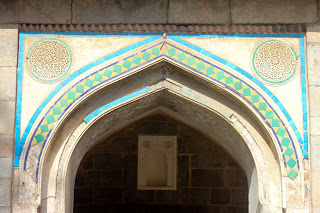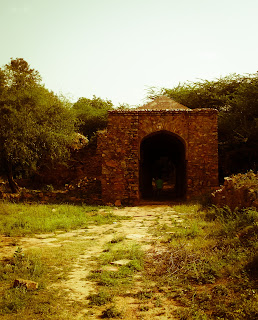Saturday, April 20, 2013
Clothier and darzi skills
My latest adventure taught me something about men's clothing.
If you're a guy, you can look like any of these models on the advert. Just follow these instructions...
Go to a clothier and choose your favorite colors in the kind of material that best suits you...
...then you go find the best, most highly recommended darzi (tailor) and have him measure you.
With any luck, they can make you look like an angel.
Cathedral Church of the Redemption
The Cathedral Church of the Redemption has been just behind the parliamentary houses in Delhi since the 1930s.
It was the Viceroy Church, built near to the Rashtrapati Bhavan for the British Viceroy and other officers.
It was decided that a church was needed in the Raisina Hill area and Sir Edwin Luyten oversaw a competition for it's design.
Henry Medd's design was chosen and construction begun.
Even King George donated toward its construction.
The walls were built thick and heavy with the intent of keeping out the heat and creating a cool interior.
The church can still keep a person cool on a Sunday morning during one of it's three services in English, Tamil or Hindi.
It was the Viceroy Church, built near to the Rashtrapati Bhavan for the British Viceroy and other officers.
It was decided that a church was needed in the Raisina Hill area and Sir Edwin Luyten oversaw a competition for it's design.
Henry Medd's design was chosen and construction begun.
Even King George donated toward its construction.
The walls were built thick and heavy with the intent of keeping out the heat and creating a cool interior.
The church can still keep a person cool on a Sunday morning during one of it's three services in English, Tamil or Hindi.
Friday, April 19, 2013
Isa Khan's tomb

In the saga of my favorite Mughal emperor, Isa Khan was an advisor of Sher Shah and his son, rivals of Humayan.
Yet his tomb and masjid--built before Humayan's--are inside the Humayan complex.
The walled area has been closed off to visitors for the past two years due to reconstruction work. When I heard the gate was opening back up this month, I wanted to go.
No: I had to go.
Isa Khan lived to be 95 years old, so he had time during his life to design his tomb and the masjid that stands nearby.
He brought over architectural influences from his Pashtu, Afghan background in the glazed tiles and the chattris.

He put up pillars and carvings...
He probably never imagined that he and Humayan--exiled at the time of Isa Khan's death--would be tombstone neighbors. Or that those who visited his garden would actually have come to see his enemy's tomb.
Life--and death--doesn't seem to follow our plans.
Thursday, April 11, 2013
Tomb mystery
One of the interesting things in all of my reading and research over Mughal history and architecture means I sometimes find unexpected links. Mysteries I once thought unsolvable--for my limited knowledge and information base--come unraveled.
In reading about Balban and learning his story, I came across a picture of a place I'd been before. The caption sited it was the tomb of Khan Shahid, Balban's son. Khan Shahid died fighting against the Mongols--the actual Ghengis Khan people who had captured and enslaved his father.
When I first came upon this tomb, the historical marker was overgrown and uninteresting. Somebody Khan died--aren't they all named Khan, and didn't they all die?
The tomb was an enchantingly overgrown structure. It may not be the most well preserved, but that's just what makes it so appealing--the trees and vines winding through all the old stones and pillars.
And now what makes it even more appealing is that I can place it in context historically. It represents Balban's greatest loss and the end of his sultanate legacy.
The impervious dictator died a broken man when his dreams died with his son. And this is all that remains today of his grief written in brick and concrete.
The first dome
There's a sign near this structure that claims it has the first dome in North India.
It is near to Balban's tomb--where the claim of "first arch" is located. The rumor is that the tomb also claimed the first dome, but since it is gone, the Alai Darwaza gets that monicker.
So I don't know if what we have here is a poser or a false claim or just confused architecture (because does that look dome-like to you?).
Just reporting what the sign says.
It is near to Balban's tomb--where the claim of "first arch" is located. The rumor is that the tomb also claimed the first dome, but since it is gone, the Alai Darwaza gets that monicker.
So I don't know if what we have here is a poser or a false claim or just confused architecture (because does that look dome-like to you?).
Just reporting what the sign says.
Balban's neglected tomb
Ghiyas ud din Balban is the warrior slave who took over the sultanate of Delhi after Iltutmish, Razia Sultan and her unsuccessful brothers.
As a child he was captured by the Mongols and sold into slavery. Bought by Iltutmish, he climbed his way up through political and military gain, finally declaring himself emperor when there was no male heir for the throne.
Balban was an iron-fisted ruler.
He established an efficient espionage system, breaking up the noble networks and their opportunities for hatching plots to usurp the throne.
He was tough on crime and set up garrisons of Afghan soldiers to keep peace and carry out strict justice for all classes. He ordered that the forests the bandits hid in be destroyed so they would have no where to take refuge.
One of the most important battles he fought was against the Mongols--the very power that had originally stolen him from home, enslaved him and set him on the path towards Delhi. He successfully defeated them and kept them out of his territory, but lost his favorite son in the battle.
Balban subscribed to the Divine Right of Kings and he is the one who put 'sijda' into practice--to greet the sultan, people had to kneel and touch their head to the ground. He thought he was God's representative on earth, was guided by God and was, therefore, above any public scrutiny. There was no room to question his actions. To keep people in a proper state of awe, Balban was followed around by tall, fearsome looking guards with their swords constantly out and at the ready.
It could be dangerous just to smile when Balban was around.
Architecturally, Balban's tomb complex claims the first true arch built in India.
The conservationists have been at work here, but the last 700 years have taken their toll on the tomb.
Even a "divine right" to rule can't make a man or his tomb eternal.
As a child he was captured by the Mongols and sold into slavery. Bought by Iltutmish, he climbed his way up through political and military gain, finally declaring himself emperor when there was no male heir for the throne.
Balban was an iron-fisted ruler.
He established an efficient espionage system, breaking up the noble networks and their opportunities for hatching plots to usurp the throne.
He was tough on crime and set up garrisons of Afghan soldiers to keep peace and carry out strict justice for all classes. He ordered that the forests the bandits hid in be destroyed so they would have no where to take refuge.
One of the most important battles he fought was against the Mongols--the very power that had originally stolen him from home, enslaved him and set him on the path towards Delhi. He successfully defeated them and kept them out of his territory, but lost his favorite son in the battle.
Balban subscribed to the Divine Right of Kings and he is the one who put 'sijda' into practice--to greet the sultan, people had to kneel and touch their head to the ground. He thought he was God's representative on earth, was guided by God and was, therefore, above any public scrutiny. There was no room to question his actions. To keep people in a proper state of awe, Balban was followed around by tall, fearsome looking guards with their swords constantly out and at the ready.
It could be dangerous just to smile when Balban was around.
Architecturally, Balban's tomb complex claims the first true arch built in India.
The conservationists have been at work here, but the last 700 years have taken their toll on the tomb.
Even a "divine right" to rule can't make a man or his tomb eternal.
Ruins of the 'obviously flourishing'

Because the sign was so enthusiastically worded, I took it's picture.
Yes, these are some cool ruins dug up by the ASI. For those who dream of being an archeologist, Delhi is probably a dream job.
There's enough here to rival Pompeii if you wanted to use your imagination to see how people of earlier years used to live.
This civilization is only missing a tragic, volcanic ending. Instead it just died a normal death of old age and population migration.
Jamali Kamali

Jamali Kamali is a pretty mosque and tomb in the Mehrauli Archeological park.
Jamali was a sufi saint and poet from the time of Lodi, Babur and Humayan (one of his favorites). The complex was built during Humanyan's reign.
Jamali Kamili has a fairly infamous reputation as one of India's "most haunted" places.
Rumors of apparitions, tv shows and the unknown identity of the second tomb, that of Kamali, fuel the stories.
Delhites like a good ghost story
Though I'm the first to question and disbelieve historical sign markers, I've no reason to think the ASI is trying to hide anything from the public.
I saw nothing haunting during my visit other than the hauntingly beautiful texture of the red sandstone.
Sunday, April 7, 2013
Subscribe to:
Comments (Atom)




























